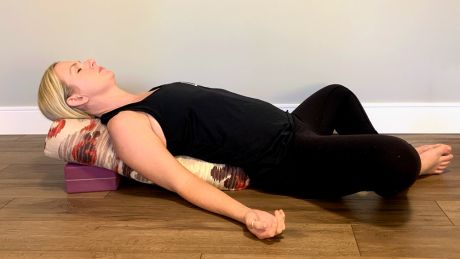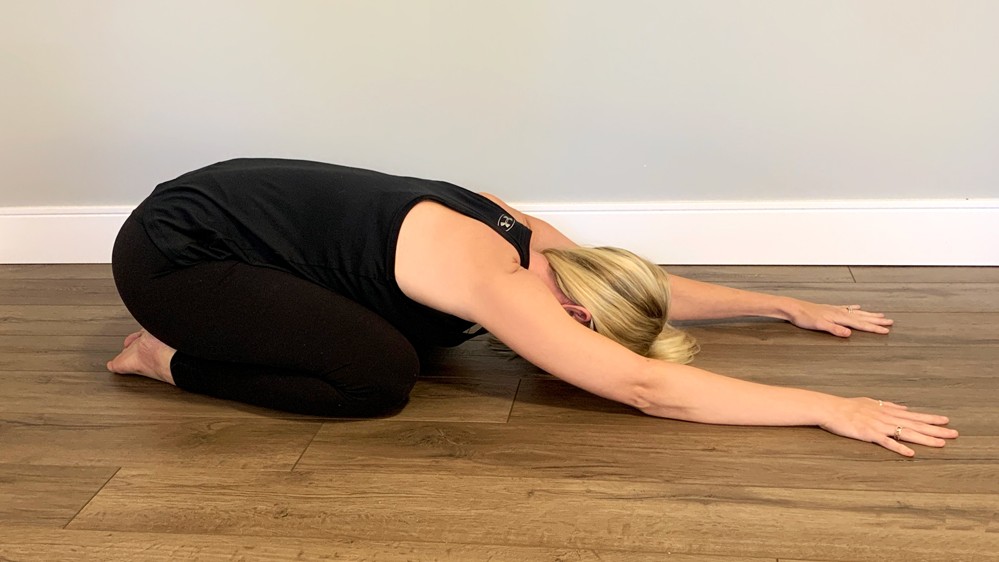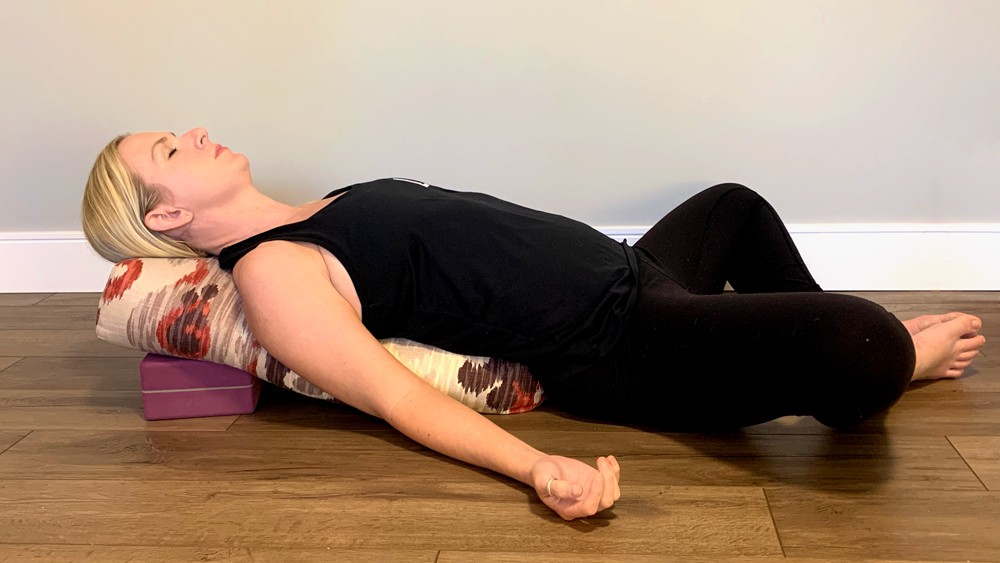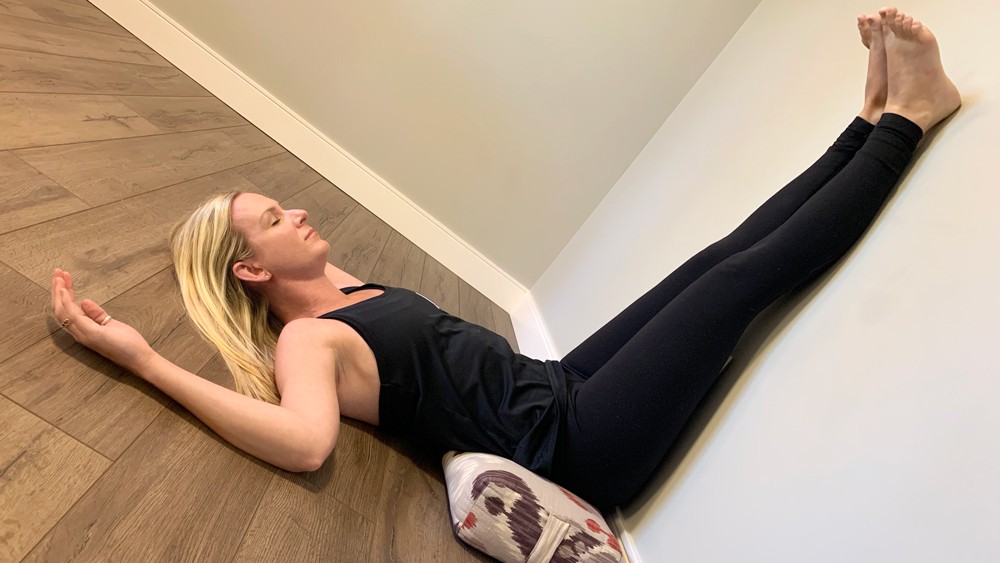Yoga Poses To Help You Sleep
Wind down with these gentle, sleep-improving poses

There are a lot of reasons to make yoga part of your exercise routine, but one that you may not have considered is that it can help you get to sleep. We’re not talking about challenging inversions or hot yoga, where you’ll be sweating way too much to get sleepy, but instead the gentler side of yoga, which can encourage stillness and a calmer mind.
“There are a number of gentle movements and postures that are accessible to almost anyone, and can even be done while lying in bed,” says Kelsey Ravlich, a yoga instructor who’s on the Livekick app, which allows you to practise with a private yoga instructor (or work out with a PT) over a video call.
“Many people say that taking an evening yoga class helps them sleep better, but if you can't make it to the studio after work, here are four yoga poses and one breathing exercise to help with getting to sleep.
“Each of these poses can be held for as long as ten minutes, and should be maintained for at least five deep inhales and exhales. The goal of this practice is for you to start feeling calmer, more comfortable and more optimistic.”
Child’s pose (Balasana)

“This pose is a forward bend and mild inversion,” says Ravlich. “It’s wonderful for releasing tension and letting go. Feel your forehead against the mat and allow your weight to press into the floor.
“Start on your hands and knees with your knees directly under your hips and your wrists directly under your shoulders. Open your knees wider than hip-distance apart, and bring your big toes together. Move your hips back to sit on your open feet – or as close to your feet as possible – and walk your hands forwards until your forehead comes to rest on the floor.
“This is an easy pose you can do in bed. A pillow underneath your forehead is a great, comfy way to help shorten the distance between you and the mattress or the floor. If your hips are feeling tight and it’s challenging to bring them all the way back to meet your heels, slide a blanket between your hips and heels.”
Get the Coach Newsletter
Sign up for workout ideas, training advice, reviews of the latest gear and more.
See related
- How To Breathe Your Way To A Better Night’s Sleep
- Yoga For Beginners: The Benefits Of Yoga And How To Get Started
- A Beginner’s Guide To The Different Types Of Yoga
Bridge and supported bridge pose (Setu Bandha Sarvangasana)

“Lie on your back with your knees bent and feet flat on the ground,” says Ravlich. “Ensure that your knees are hip-width apart and pointed directly up. Your arms should be by your sides and your palms pressing gently into the floor.
“Gently engage your glutes, press your feet into the floor and lift your hips into the air. This part is not necessary, but to further open your chest you can walk your hands towards each other underneath your hips and clasp them together. Either hold the pose here, or continue to return your hips to the floor and then back into the air.
“You can make this pose feel a bit more supported by placing a block, a pile of pillows or a stack of books underneath your sacrum [at the base of your spine].”
Reclined bound angle pose (Baddha Konasana)

“When we’re anxious, we often take quick, shallow breaths from our chest instead of from our diaphragm,” says Ravlich. “This can increase symptoms of anxiety and make your mind race when you want it to be shutting down. Sometimes, simply shifting our attention to your breath can make all the difference. Plus, since this is a great hip-opener, you’ll be more focused on the level of relative discomfort of your hips, especially if you’ve been sitting all day long. Be gentle with yourself as you encourage each inhalation and exhalation to be slightly fuller, deepening this stretch.
“Begin by setting up a tower of pillows – one or two stacked on top of each other and one perpendicular to create a T shape. Take a seat at the base of the T and bring the soles of your feet together, creating a basic bound angle pose. Keep your feet together and lean your torso backwards onto your pillows, allowing your arms to rest at your sides or on your hips.”
Legs up the wall pose (Viparita Kirani)

“If you don’t feel like bending forwards or backwards, this is the pose for you,” says Ravlich. “In Sanskrit, this pose is called Viparita – “inverted” – Karani – “in action”. The name proclaims its ability to invert our daily actions of sitting and standing.
“There is no non-awkward way to get into this one. Place your feet against a wall and use that leverage to wiggle your hips towards the wall until your hips are resting against it. Straighten your legs so that as much of your heels, calves, hamstrings and glutes as possible are against the wall. If you aren’t happy with where you end up on the wall, you can always shift your hips closer or further away.”
Four-part breathing
“Yogic breathing exercises are really excellent to work on while lying in bed, trying to quiet your mind and fall asleep,” says Ravlich. “Four-part breathing, sometimes called square breathing, is easy to remember and a great go-to.”
“Start by taking one mindful breath in and out. From that exhalation, your four-part breathing begins. Inhale a large belly breath through your nose to the count of four. When you get to the top, lock in that breath and hold it for a count of four. Then slowly release that breath through your nose, exhaling for a count of four. Finally, hold at the bottom of that exhalation, when you have no air left, for a count of four. Repeat this three times as a minimum to begin to notice a calming effect.”

Nick Harris-Fry is a journalist who has been covering health and fitness since 2015. Nick is an avid runner, covering 70-110km a week, which gives him ample opportunity to test a wide range of running shoes and running gear. He is also the chief tester for fitness trackers and running watches, treadmills and exercise bikes, and workout headphones.
